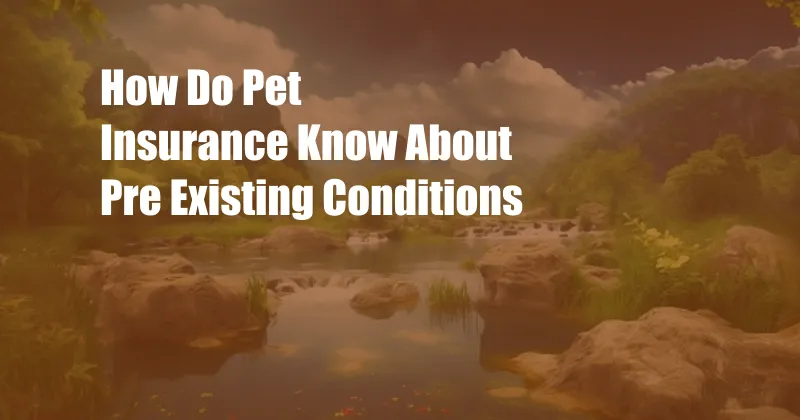
How Do Pet Insurance Companies Know About Pre-Existing Conditions?
Last year, my beloved dog, Max, became suddenly ill. As a responsible pet owner, I had purchased pet insurance to protect him against unexpected medical expenses. However, when I filed a claim for his treatment, I was shocked to discover that his pre-existing condition, a heart murmur, was excluded from coverage. It left me wondering, how did the insurance company know about Max’s pre-existing condition?
Unfortunately, my experience is not uncommon. Pre-existing conditions are one of the most common reasons for pet insurance claims to be denied. To avoid this disappointment, it’s crucial to understand how pet insurance companies determine whether your pet has a pre-existing condition.
What is a Pre-Existing Condition?
A pre-existing condition is any medical condition that your pet has before you enroll them in a pet insurance plan. It can be something as minor as a skin allergy or as serious as a heart disease.
How Do Pet Insurance Companies Find Out About Pre-Existing Conditions?
Pet insurance companies use various methods to determine whether your pet has a pre-existing condition, including:
- Veterinary Records: When you apply for pet insurance, you will be asked to provide a copy of your pet’s veterinary records. These records will show any medical conditions that your pet has been diagnosed with in the past.
- Medical History Questionnaire: You may also be asked to complete a medical history questionnaire for your pet. This questionnaire will ask about your pet’s overall health, any symptoms they have experienced, and any medications they are taking.
- Physical Examination: In some cases, your pet may be required to undergo a physical examination by a veterinarian before the insurance policy can be issued. This examination can help the insurance company to identify any pre-existing conditions that may not be apparent from your pet’s veterinary records or medical history questionnaire.
What Happens If My Pet Has a Pre-Existing Condition?
If your pet has a pre-existing condition, it is important to disclose this information to your pet insurance company. Failing to do so can result in your claim being denied or your policy being canceled.
In most cases, pre-existing conditions will be excluded from coverage. This means that the insurance company will not cover any veterinary expenses related to the pre-existing condition. However, some pet insurance companies may offer coverage for pre-existing conditions after a waiting period.
Tips for Avoiding Pre-Existing Condition Exclusions
Here are some tips for avoiding pre-existing condition exclusions:
- Enroll your pet in pet insurance when they are young and healthy. This will help to ensure that they are covered for any unexpected medical expenses, even if they develop a pre-existing condition later in life.
- Keep your pet’s veterinary records up to date. This will make it easier for your pet insurance company to determine whether your pet has any pre-existing conditions.
- Be honest about your pet’s medical history when applying for pet insurance. Failing to disclose a pre-existing condition can result in your claim being denied.
FAQs on Pre-Existing Conditions and Pet Insurance
Q: What is the definition of a pre-existing condition?
A: A pre-existing condition is any medical condition that your pet has before you enroll them in a pet insurance plan.
Q: How do pet insurance companies determine whether my pet has a pre-existing condition?
A: Pet insurance companies use various methods to determine whether your pet has a pre-existing condition, including veterinary records, medical history questionnaires, and physical examinations.
Q: What happens if my pet has a pre-existing condition?
A: In most cases, pre-existing conditions will be excluded from coverage. However, some pet insurance companies may offer coverage for pre-existing conditions after a waiting period.
Q: How can I avoid pre-existing condition exclusions?
A: You can avoid pre-existing condition exclusions by enrolling your pet in pet insurance when they are young and healthy, keeping their veterinary records up to date, and being honest about their medical history when applying for pet insurance.
Conclusion
Understanding how pet insurance companies determine whether your pet has a pre-existing condition is crucial for ensuring that you have the coverage you need. By following the tips outlined above, you can help to avoid pre-existing condition exclusions and protect your furry friend against unexpected medical expenses.
Are you interested in learning more about pet insurance and pre-existing conditions? Leave a comment below, and we’ll be happy to answer your questions.